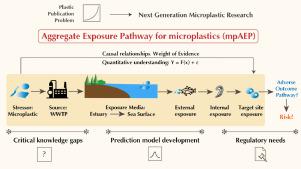Water Research ( IF 11.4 ) Pub Date : 2021-11-16 , DOI: 10.1016/j.watres.2021.117873 Guyu Peng 1 , Yan Lin 2 , Bert van Bavel 2 , Daoji Li 3 , Jinren Ni 1 , You Song 2

|
Microplastics as emerging contaminants have been detected from peaks to poles. High concerns on the risks of microplastic pollution to humans and ecosystems have therefore been raised in the past decade. While a large number of studies have been conducted to investigate the environmental levels and toxicity of microplastics, the information generated to support risk assessment is fragmented and the coherence between different types of study is largely lacking. Here we introduced the Aggregate Exposure Pathway (AEP), a conceptual framework originally proposed for chemical exposure assessment, to facilitate organization, visualization and evaluation of existing information generated from microplastic research, and to efficiently identify future knowledge and regulatory needs. A putative microplastic AEP network (mpAEP) was developed to demonstrate the concept and model development strategies. Two mpAEP case studies, with polyethylene (PE) as a prototype, were then presented based on existing environmental exposure data collected from the Changjiang Estuary and the East China Sea (Case I), and the Oslo Fjord (Case II), respectively. Weight of evidence (WoE) assessment of the mpAEPs were performed for evaluating the essentiality, theoretical plausibility, empirical evidence and quantitative understanding of the evidence and relationships in the AEPs. Both cases showed moderate/high WoE to support the strength of the models, whereas also displayed clear knowledge gaps, thus providing guidance for future investigations and regulations. The mpAEP framework introduced herein presents a novel strategy for organizing fragmented information from diverse types of microplastic research, enhancing mechanistic understanding of causal relationships and facilitating the development of quantitative prediction models for research and regulation in the future.
中文翻译:

微塑料的总体暴露途径 (mpAEP):确定研究和监管需求的循证框架
作为新兴污染物的微塑料已被检测到从高峰到极点。因此,在过去十年中,人们对微塑料污染对人类和生态系统造成的风险提出了高度关注。尽管已经进行了大量研究来调查微塑料的环境水平和毒性,但为支持风险评估而生成的信息是零散的,并且不同类型的研究之间很大程度上缺乏一致性。在这里,我们介绍了聚合暴露途径(AEP),这是一个最初为化学品暴露评估提出的概念框架,旨在促进微塑料研究产生的现有信息的组织、可视化和评估,并有效地识别未来的知识和监管需求。开发了推定的微塑料 AEP 网络 (mpAEP),以演示概念和模型开发策略。然后,根据分别从长江口和东海(案例一)和奥斯陆峡湾(案例二)收集的现有环境暴露数据,提出了两个以聚乙烯(PE)为原型的mpAEP案例研究。对 mpAEP 进行证据权重 (WoE) 评估,以评估 AEP 中证据和关系的重要性、理论合理性、经验证据以及定量理解。这两个案例都显示出中/高的 WoE 来支持模型的强度,同时也显示出明显的知识差距,从而为未来的调查和监管提供指导。 本文介绍的 mpAEP 框架提出了一种新颖的策略,用于组织来自不同类型的微塑料研究的碎片信息,增强对因果关系的机械理解,并促进未来研究和监管的定量预测模型的开发。











































 京公网安备 11010802027423号
京公网安备 11010802027423号